While watching "Four Tankmen and a Dog" for the hundredth time, did you wonder what a miracle this good-natured, straightforward Russian and a bit crazy, geeky Georgian found themselves in in the Polish unit? We have the answer to this compelling question. But not every fan of the series will like the facts.
When General Zygmunt Berling asked Joseph Stalin for permission to create, in parallel with the 1st Infantry Division, a tank regiment, the Soviet dictator asked him one short question: What about the cadre ? The Red Tsar, of course, knew very well the fate of the Polish officers who fell into the hands of the NKVD torturers .
Meanwhile, to create a regiment according to Soviet posts, 572 people (including 112 officers), and mostly qualified specialists, were needed. The position of the brigade was of course even larger and numbered 2,188 soldiers (including 1,139 officers and non-commissioned officers).
Berling - quoted in the book by Kacper Śledziński “Tankiści. The true story of the four tankers "- only knew that he would not find any officer cadre of such a military specialty at all . He could only dream about the experts who came from the pre-war Polish army and the Polish Army in France, and who are now part of the 1st Armored Division of general Maczek. Although in the USSR, in the Kyrgyz village of Kainda, an Armored Weapon Training Center was established in January 1942, these soldiers evacuated with General Anders to Iran two months later.
Stalin's generous gesture
The Soviet commander not only agreed to create a Polish armored unit. He also ensured an influx of "Poles" officers from the Red Army. The criteria for selecting the right people were not too high. Of course, the candidates had to come from armored units. It was also desirable that they had Polish-sounding surnames, preferably with the ending "-ski", and… that's all .
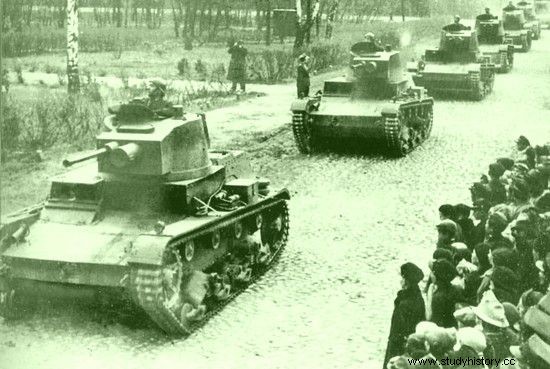
The pre-war tankers in the ranks of Berling's army were like medicine. Almost the entire cadre had to be trained from scratch or "borrowed" from the Red Army. The photo shows the pride of the armored weapons of the Second Polish Republic, the 7TP tanks.
There were only a dozen Poles from pre-war armored units, and only non-commissioned officers. The rest of the regiment was to be composed of Polish citizens deported from the former eastern provinces of the Republic of Poland, freed from labor camps and prisons under the Sikorski-Majski pact. These people, for various reasons, did not manage to reach Anders' army, and thus they became the nucleus of the Polish armored forces created under the auspices of the Soviets.
Sojuzniki will help
It is difficult to clearly define what proportion of the cadre were Soviet citizens. For example, in the 1st Infantry Division at the beginning of July 1943, they constituted 67% of all officers. In the 1st Tank Regiment, and after its reformation into the 1st Armored Brigade as a technical unit, this percentage had to be much higher. In the entire Polish People's Army at the end of 1944, the Russians constituted 40% of the cadre .
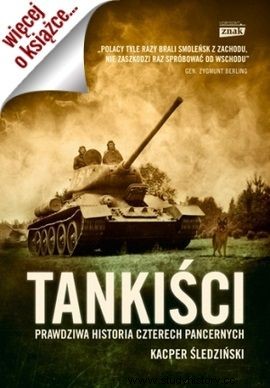
This state of affairs, despite the announcement of mobilization in the liberated Polish lands, the launch of a network of Polish officer schools and sending Poles to courses in Soviet schools, increased and in mid-1945 amounted to 45% (almost 19,000 soldiers).
Soviet comrades took all the most important positions in the headquarters of the Polish unit. They also acted as instructors, driver mechanics, commanders of tanks, platoons and companies.
Some sub-units of the brigade consisted entirely of Red Army soldiers. A good example is the 13th Self-Propelled Artillery Regiment, armed with 13 SU-85 guns, and including 70 officers and 267 non-commissioned officers and privates. Mixed Polish-Soviet tank crews were also a norm.
Я граб три
Also, during the brigade's fights in Poland, as part of the replenishment, carts operated entirely by Soviet personnel were sent from the Soviet units. It happened just before the attack on Wejherowo, when the Polish unit was enriched by 10 T-34s from the Soviet 64th Brigade.
At the end of March 1945, before the final attack on Gdynia, the personnel situation in the "Polish" brigade looked particularly bizarre. Only 15 tanks (out of 65 full time) were ready to fight. As emphasized in his book by Kacper Śledziński , Poles constituted only 10% of the crews - they manned 1.5 tanks!
The language barrier was also a big problem. It got so that Berling by order forced the Soviet comrades to learn Polish . Despite this, the Russians, especially in the headquarters, parading in Polish uniforms, did not even try to keep appearances and used Russian widely. By the way, I wonder what the radio correspondence between the command and the tanks looked like in such conditions and whether this immortal "I Grab Trzy" was sometimes reported in Russian?
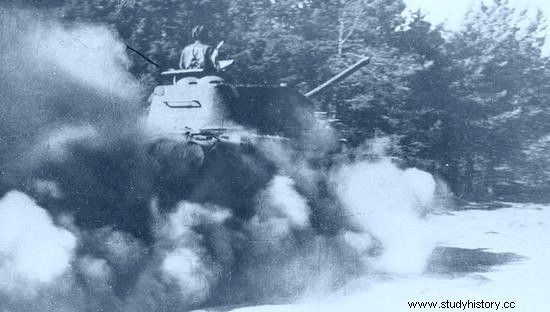
Is the Soviet crew driving in this tank of the 1st Armored Brigade? It is quite likely.
The staffing situation in this new Polish army is perfectly illustrated by a certain situation, when a group of Poles going to an idyllic camp saw a Polish soldier at a railway station. Happy to meet their compatriot in Polish uniform, they rushed towards him, surrounded him and curiously began to inquire about various matters related to the Polish army.
They were surprised that the soldier was somehow reluctant to answer them in Russian as well. Finally, more and more insulted, he pouted and angrily replied:[get away from me what the f *** you want] .
Drunk as a log commander
The Soviets in the Polish armored brigade were people with varying degrees of professionalism and competence. In a few cases, the parent units seemed to have seized the opportunity and simply got rid of them. The most striking example is Lt. Col. Anatoly Wojnowski, commander of the 1st Tank Regiment.
Despite his Polish sounding name, he did not admit to having Polish roots. Besides, he didn't even know the language. A Knight of the Order of Lenin for participating in the Spanish Civil War did not hide the fact that he did not like his service in the Polish Army. He despised his soldiers and had one more negative, especially in war conditions, quality:he was an alcoholic . Together with the chief of staff, Maj. Jurasov, his deputy Cpt. Kozakow and the technical officer of Maj. He regularly held drunken libations with Demianowicz.
The incident echoed loudly when, as stated by the political officer of the 1st Infantry Division, Jerzy Putrament, quoted in Kacper herringski's book: The regiment commander got married and does various things, the least trivial of which is shooting at privates .
After this event, General Zygmunt Berling intended to remove him from command. However, due to the fact that a decision was made to organize the tank regiment of the armored brigade in place of the tank regiment, the drink remained in it (and it had a specific promoter in the person of General Świerczewski).
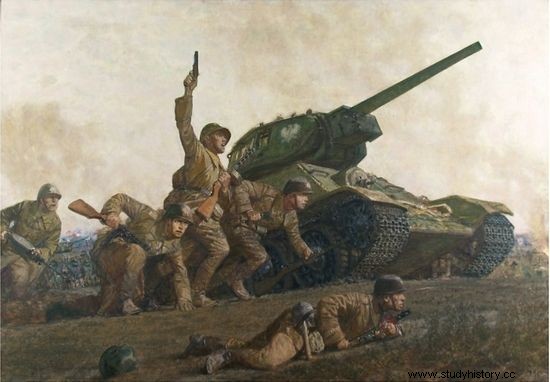
The Battle of Leniono clearly showed the value of Lt. Anatoly Wojnowski as the commander. He was completely drunk when his soldiers were killed.
His value as a commander was proved by the Battle of Lenino. At the most important moment, when it was necessary to organize the cooperation of tanks with the soldiers of the 1st Infantry Division. Tadeusz Kościuszko, was absent. As it turned out, was lying drunk in a shock . This finally poured bitterness, Wojnowski was dismissed from service and reportedly drank himself to death in a penal company .
A Russian man too
Of course, it would be unfair not to mention the Soviet officers who made a positive mark in the history of the 1st Armored Brigade. Heroes of Westerplatte. Major Piotr Czajow was undoubtedly one of them. He was an officer with high personal culture, great general and military knowledge . It was him in the battle of Lenino, in the absence of drunk Wojnowski, who tried to coordinate the actions of Polish tanks.
The actual organizer and first commander, Gen. Jan Mierzycan, also left a special mark on the armored brigade. A Pole by origin, he volunteered for the Polish army, for which Zygmunt Berling appreciated him. Thanks to Mierzycan, the Polish unit became a real and efficient fighting force, and it was under his orders that the Tankists went into battle at Studzianki.
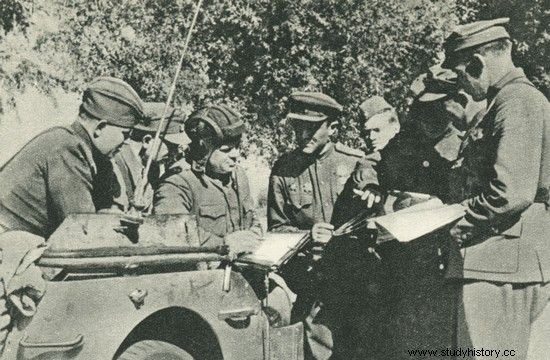
Among the Soviet officers who found themselves in the 1st Armored Brigade, there were also those who remembered their subordinates well. This was the case with Gen. Jan Mierzycan (wearing a headphone).
The Soviet core of the Polish army
The citizens of the USSR constituted the core of the staff of all units of the Polish People's Army and the 1st Armored Brigade was not a phenomenon in this respect . It should also be added that they were not only Russians, but also Ukrainians, Belarusians, Jews, Tatars, Armenians, Georgians, Kazakhs, Azeris, Latvians, Lithuanians, and even Greeks, or such exotic nations as the Chuvash, Mordvin and Komiacy.
Yes, these people contributed to the liberation of Polish lands from German occupation. But it should also be remembered that, although they fought side by side with the Poles, often giving evidence of self-sacrifice and bravery, they were only obedient executors of Moscow's will . And this one had its own vision of Poland, which definitely did not take into account our interests and expectations.
